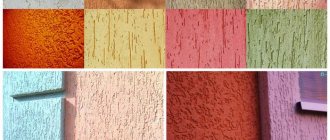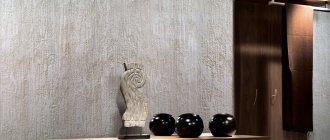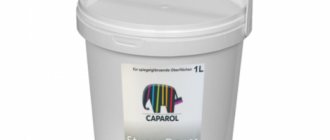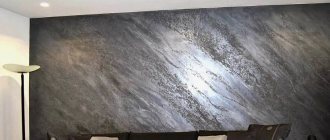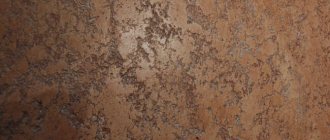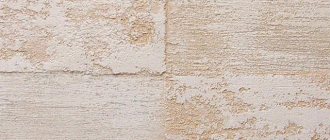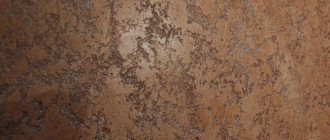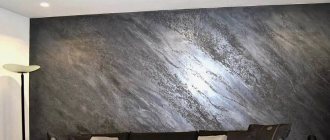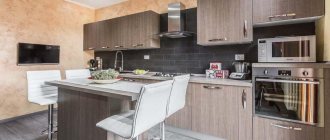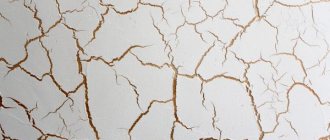With the help of decorative plaster, you can add a delightful twist to the interior of any room and make it exclusive. It is much more interesting and more in demand than traditional types of finishing.
Before deciding on such a decorative coating, you need to learn about its features and types. Understand the varieties and decorative qualities of each of them. Find out whether it is possible to make a decorative mixture with your own hands and how to apply it correctly.
Features of decorative plaster
Decorative plaster is a composition in the form of a solution that is used for finishing walls. They are used to decorate both the external walls of the building and the internal premises.
The main purpose is to give the treated surfaces high decorative and aesthetic qualities.
They go on sale:
- in finished form (diluted with water or solvent);
- semi-finished products to which you can add fillers at your discretion.
Wall decoration can resemble marble, metal, hides, whitewash, silk or granite.
Experienced designers can even achieve the effect of a three-dimensional surface using various additives.
Advantages
This is a universal coating preferred by many designers, architects and decorators.
Its advantages:
- Does not require additional processing or surface leveling before application. For better adhesion, you just need to apply a primer first.
- She's viscous. This composition makes it easier to decorate complex surfaces. You can work with semicircular walls, niches, plasterboard structures, columns.
- When dry, the surface has a solid appearance. Does not create seams or joints. This is facilitated by the technology in which it is applied gradually layer by layer. The master does not allow it to dry out and take an irregular shape.
- Allows you to create room decor according to your planned project. You can color the mixture at any time.
- A large number of types of decorative plaster allows you to create any ethnic or historical style.
- You can apply special mixtures or a protective coating. Thanks to this, its original appearance is preserved for a long time. It does not wear out, the texture is preserved, and the colors do not lose their freshness.
- Eco-friendly. Only natural ingredients are used in the mixtures. It does not absorb harmful components from the atmosphere, therefore it is not toxic.
- Frost-resistant, moisture-resistant. Provides good insulation from aggressive external environments.
- Robust, durable and practical. When working with it, you must comply with all standards required by the manufacturers' instructions.
With the help of this coating you can create such a beautiful and interesting design that other finishing materials cannot do.
Flaws
However, this type of coating is not used everywhere.
There are significant reasons for this:
- High cost of material and labor.
- Requires surface cleanliness during application.
- Insufficient strength for walls. Some types of plaster are only suitable for finishing ceilings.
- Not suitable for houses in seismically active areas. May crack and collapse during shocks.
- It is very difficult to remove from the walls. Dismantling takes a lot of effort and time.
In addition to seismically active zones, it is not recommended to use it when decorating premises in new buildings. The decorative surface may develop cracks over time. This occurs due to shrinkage of the soil under the building.
Where is it better to use
This plaster can be used in finishing in any interior style. She looks great on her own. It can be perfectly combined with other types of finishing: tiles, decorative panels made of different materials, wallpaper.
By area of application it is:
- for facades;
- for interior decoration.
It is used to decorate not only public premises, but also small residential ones. In apartments it is even suitable for finishing kitchens and bathrooms.
Florence on lime base
Florence decorative plaster created on a lime basis allows you to create a wide variety of decorative effects. We are talking not only about the traditional “bark beetle” or imitation stone, but also about such rare phenomena as the effect of balsa wood. All this is possible thanks to the composition of the material, which includes modern additives and mineral fillers.
This material is suitable for interior use only. To work, you will need a plastic float, a trowel, a construction sponge and a paint brush. You can learn about applying textured plaster from the video below.
Types of plasters by composition
The decorative mixture includes cement, lime and sand. Plasters differ from each other in composition and additives.
Additives are a variety of dry bulk substances in the form of small granules: stone chips, marble dust, wood fibers, wax and others.
If we divide plaster according to its composition, we can distinguish several main types:
- cement;
- acrylic;
- silicate;
- silicone.
To choose the right material for the job, it is worth taking a closer look at each of the listed types.
Cement
This coating is used for exterior, facade work and interior decoration. The difference is that mixtures for industrial and decorative purposes contain cement in different proportions.
It can be partially or completely replaced with lime, gypsum or clay. In addition to them, sand and lime are also added to the decorative layer.
Its advantages:
- inexpensive;
- high degree of adhesion to the surface;
- masks unevenness of the ceiling and walls;
- good noise insulation properties;
- durable;
- fire resistant;
- moisture resistant;
- has good thermal insulation.
Most often, such mixtures are used to create an imitation of brickwork. Craftsmen sometimes have to mask the “cement” appearance of a decorative surface.
Flaws:
- unstable to mechanical damage;
- service life up to 10 years;
- Available only in white;
- requires additional time for preparation.
Gypsum-based material is used when working with wooden, polymer, clay or ceramic surfaces. Cement-based plaster simply does not stick to them.
Acrylic
This finishing element is a mixture based on acrylic resins (high molecular weight polymers).
Usually supplied already in the form of a water-dispersion mixture.
Advantages:
- purchased ready-made;
- easy to apply to the wall;
- dries quickly;
- long service life (15-25 years);
- high degree of adhesion to all mineral bases.
Great for bathrooms or areas with high humidity.
Based on it, a large number of types of textured coatings are produced. Its versatility allows the use of decorative finishing in rooms of all styles.
The disadvantages of this material include the fact that it:
- flammable;
- gets dirty quickly.
When working with the mixture, you must cover your eyes and nose and make sure that the plaster does not get on your mucous membranes.
Silicate
Silicate plaster is a mixture based on liquid glass. Mineral fillers and pigments are used as additives.
The advantages include:
- it is vapor permeable and allows the walls to “breathe”;
- elastic, without cracks;
- waterproof;
- Dirt is easily washed off from it.
It is widely used for outdoor work. It serves as excellent protection from wind, rain, and steam.
However, not all people can work with these mixtures. This requires skills.
Flaws:
- sets and dries quickly;
- limited color range;
- selective adhesion;
- fades in the sun;
- quite expensive.
Before applying to some surfaces it is necessary to apply an additional silicate primer. Apply whole planes at a time.
The types of these mixtures differ in fillers. These can be small stones, coarse sand, marble chips and more. The effect of rough surfaces is often created. Such compositions have names such as “fur coat”, “bark beetle”, “lamb”.
Silicone
This decorative mixture contains natural silicone.
Has a lot of advantages:
- does not fade because it is not sensitive to ultraviolet radiation;
- easy to apply to any surface;
- resistant to any negative natural factors;
- you can work with it even at sub-zero temperatures and high humidity;
- very flexible and economical, applied in a thin layer;
- vapor permeable;
- Available in a wide range of colors;
- resistant to mechanical damage.
Additionally, many manufacturers add special additives to these mixtures against the formation of fungus and mold.
However, surfaces for silicone mixtures must be prepared very carefully.
Disadvantages also include:
- high price;
- there are many fakes on the market;
- old coating is very difficult to remove.
But this type of mixture does not require additional dilution. And with its help you can create any texture designs.
Loft Concrete
As you can guess from the name, decorative plaster Clavel Loft Concrete creates a texture that imitates concrete. In this case, the surface being treated does not need to be leveled to perfection. The base layer is applied with multidirectional strokes. The desired layer thickness does not exceed half a centimeter. The resulting sloping pattern is what we need. After a day, the base layer will dry, after which it needs to be treated with the edge of a trowel. If necessary, use sandpaper to get rid of rough areas. The finishing solution is applied on top, but only after cleaning the surface from any dust that has formed. The base pattern does not overlap. While the finishing layer is drying, you should spray it with water, smoothing everything with a trowel.
Types of plaster according to decorative qualities
Decorative plaster allows you to create unique and expressive patterns on the walls. Some creative individuals manage to sculpt real masterpieces.
Using special techniques, surfaces can be given the following effects:
- aging;
- cracking;
- volume;
- rough surface;
- silks;
- relief.
But the point here is not in the skill of the decorators, but in special substances - fillers.
To work effectively with it, it is necessary to distinguish between types of plaster according to their decorative qualities.
Structural
Structural plaster appeared on the market not so long ago. It is a heterogeneous granular mass. They are based on binders and fillers (synthetic and natural fibers, sand, granules, crumbs)
Potassium silicate (silicate plasters), synthetic latex (latex plasters), and cement-lime composition are used as a binder.
There are two types of structural plasters:
- water based;
- solvent based.
Hence the classification of these mixtures: water-borne and organic-based.
However, it must be taken into account that it cannot be used in bathrooms and damp rooms. Has the ability to collect dust and excess moisture.
It gained its popularity due to the fact that it allows you to create a variety of surfaces.
There are three types:
- With a smooth surface. Available in various color shades.
- Plaster having a certain texture. When working, stencils are used.
- Textured plaster. Arbitrary drawing techniques are used.
It's quite easy to apply. The main thing is to strictly monitor the application technology.
Plaster with silk or flock look
Silk-look plaster (or flock) gives the appearance of silk fabric stretched over a wall. Silk threads are visible, pearlescent highlights shimmer.
The effect of silk-screen printing is achieved due to the fact that particles of natural or artificial silk are introduced into the mixture. Available in the following colors: white, gold, garnet, silver and bronze. Tinting is allowed.
The mixture is supplied dry and diluted with water according to the instructions. It is applied manually or using a sprayer. Unlike conventional silk-screened wallpaper, there are no joints on the walls.
Great for finishing kitchens.
Marble
In marble decorative finishing, dust and crumbs formed during the processing of marble at mining and processing enterprises of various rocks are used as a filler.
Emulsions based on acrylic, lime, and polymer resins can be used as a binder. In addition, coloring additives and antiseptics and water-repellent preparations are introduced.
Marble chips used as filler have the following features:
- this is a durable material for wall decoration;
- the result is a coating with a rough texture that looks beautiful and stylish;
- has excellent adhesion to various surfaces.
It has a wide range of colors, close to natural stone. Maybe with the addition of granite chips, then it is called granite-marble.
This coating has a drawback: it is susceptible to exposure to certain chemicals. In particular, it does not tolerate acids.
With a Venetian view
Venetian decorative plaster is considered the most spectacular and sophisticated among all types. Externally it resembles the surface of natural onyx or marble. Sometimes it imitates precious metals; for this purpose, the surface is painted with special pigments.
It is also considered the most difficult to work with. Its application requires experience and skill. And its cost is more expensive.
It is a mixture of organic components with an acrylic binder. The composition includes natural chips of various types: quartz, granite, marble.
There are two types:
- embossed;
- smooth (glossy, semi-matte, matte).
Available in a wide range of colors. You can apply compositions of two or three shades.
When working with it, it is necessary to take into account that the more layers are applied to the surface, the deeper the color and the more luxurious the finish. To enhance the gloss, the surface must be coated with special wax and sanded.
This plaster is not suitable for outdoor use. It is intended for indoor use only. Although it can withstand large temperature changes.
Capricious to the surface. The base for application must be perfectly smooth, even, dry and clean.
Africa
Decorative plaster Africa (or AFRICA) is a series of exclusive metallized decorative thin-layer plasters with a silk effect. There are 16 colors in total in the collection. They bear the names of cities on the African continent.
They are distinguished by their rich colors and velvety-silky texture. Every year a new color is added.
Suitable for decorating rooms in ethnic style.
Supplied ready-made, does not require dilution with water. Apply in two or three layers. Afterwards it is coated with a special varnish for protection.
Marseille wax
A characteristic feature of a type of decorative coating called Marseille wax is a rather deep surface relief.
It can imitate texture:
- stone;
- wood;
- sandstone
In addition, you can create various interesting drawings.
The coating is pleasant to the touch.
Distinctive feature: glaze finish. Outwardly, this is expressed in the fact that the color is distributed unevenly over the surface. It is lighter at the tops and darker at the recesses. This creates the effect of an “aged surface”.
Suitable for interiors in Provence and Modern style. It is often combined with natural stone inserts.
Other types of plastering structures
There are also specific types of decorative coatings. They are also beautiful, safe, reliable and durable.
These include:
- Sea breeze. The structure is translucent, with a slight pearlescent tint. Contains fine-grained sand. Basic colors: white, garnet, gold, bronze and chameleon.
- Colored plaster. Contains acrylic and marble chips. The surface is quite hard and waterproof. The color range includes 15 shades. Excellent adhesion to mineral surfaces. Apply in one layer.
- Versailles plaster. Imitates the gilded stucco work of the Palace of Versailles in Paris. Has a pearlescent sheen. It contains silver and quartz. It's quite expensive.
- Roller plaster. When applied, a texture with small channels-indentations is formed. This is due to the fact that it contains filler of natural origin of various fractions from 1 mm to 2.5 mm. Features of work: applied to the surface with a spatula, and rubbed with a trowel in different directions. This makes for an interesting drawing. After drying, it is tinted or painted.
- Latex plastic. This plaster imitates various relief surfaces. Thanks to it, a smooth coating with a slight gloss is created, imitating the texture of smooth stone or marble. To create a marble effect, do not diligently stir the colors. Tinting in different colors is allowed. It is quite capricious in application: the walls must be smooth, pre-plastered and treated with a deep penetration primer. At the same time, it is very moisture resistant, the surfaces can be washed. Resistant to cracking.
- French-made decorative plaster for creating interiors in a fashionable, eco-friendly style. After treatment, the walls look like they are covered with lime, whitewashed or with adobe finishing (adobe, mud). The composition contains mineral and plant fibers. Some types can only be tinted by hand.
Some time after application, they can be coated with a wax composition. It can be transparent and with a mother-of-pearl effect. This layer serves to increase the service life of the decorative coating.
Encausto - replacement of polished marble
The Encausto coating has the appearance of polished marble with small grains of terracotta. Environmentally friendly Encausto is applied using a spatula. The pre-white material should be tinted to your liking. The base is applied in a small and even layer. Moreover, you should press down firmly with a spatula when applying the solution so that the coating is as even as possible. The base is made white, but the main decorative Encausto plaster is already painted in the desired color.
The second layer is applied 8 hours after the first. Let it dry for 6-8 hours, after making it even and smooth. Another 2-3 layers are applied randomly in different directions. The finishing coat should be as thin as possible to avoid cracks. The coating pattern depends on how the finishing layers are applied to each other.
How to choose plaster
Textured coating transforms the interior. Makes it richer, more spectacular. It can be used as a self-sufficient finishing element and combined with tiles, wallpaper, wood panels and wallpaper.
When selecting a coating for individual rooms, it is necessary to take into account its climatic parameters. Almost any type of decorative textured coating is suitable for the bedroom and living room.
And for the bath and kitchen, you need something more resistant to moisture, which can be periodically repainted and updated.
Living room
In the living room, textured coating can be used as the main decoration. However, if you wish, you should not limit yourself to just one material.
You can make stucco elements on the ceiling, and decorate the walls with colored material of a warm shade with good reflective ability. To make the interior look elegant, most often everyone opts for Venetian plaster with a golden or silver sheen.
Bedroom
Plaster that imitates silk will look great in the bedroom.
The shades are calm, muted, or dark.
To create a volumetric effect, a mixture with large fractions is suitable. It will also highlight the architectural elements of the room.
If you want to impress with a trendy bedroom interior (in African or Moroccan style), the AFRICA mixture is perfect. The texture of the coating is warm, soft, silky.
Kitchen and bathroom
For the kitchen and bathroom, a durable coating designed for difficult climatic conditions is selected.
The manufacturer must indicate that it can withstand fluctuations in humidity and temperature and is breathable. The composition contains compounds that prevent the formation of mold. In this case, homeowners are not at risk of fungus on the walls and will not have to change the coating after a while.
To protect the decorative coating after drying, it is best to cover it with paint or wax. This will allow you to clean it in the future by simply wiping it with a damp cloth.
Colors and design
The possibility of designing the interior of rooms in one style or another depends on the finishing material used. If the premises need to be given the features of long-term reliability, aristocracy, luxury, Venetian plaster is used: the types of design are diverse.
Several design methods for decorative finishing:
- Gloss
- a frequently used technique. It is achieved by applying a wax layer followed by polishing the coating.
- Design for concrete
. This plaster has high performance qualities; the rough texture is created by adding sand and fine pebbles.
- Nacre
. Its addition to any type of Venetian mixture helps to create an original type of interior due to the shimmer, flickering of light - the effect of shining pearls.
- Gold plating
. The atmosphere of the room from such decor is filled with luxury and wealth.
- World map illusion
. The outlines of seas and continents distributed along the wall will appeal to travel enthusiasts.
The colors of Venetian putty are represented across the entire spectrum of the rainbow; they can be used to decorate the interior of any room, but the predominant shade is white. By adding pigments to it, the desired color is obtained.
The color values for finishing materials can be seen in the table.
| Color | Description |
| Black | Combines with all colors. Marble of this color looks aristocratically strict |
| Grey | Fashionable, practical trend, fits into all styles |
| White | Enhances the brightness of other shades and decorative elements |
| Blue | Creates a calm, relaxing interior |
| Green | Creates a comfortable atmosphere of summer, freshness of nature |
| Blue | Delicate and sophisticated, contributes to a soulful, soft atmosphere in the room |
| Turquoise | Bright, rich - transforms the room, becomes its main accent |
| Silver | Moonlight color - fills the room with mystery |
| Beige | Neutrality of shades contributes to the creation of a calm and elegant design |
The most popular colors are those found in natural stones. Venetian putty can be given the desired color by adding synthetic dyes to the composition.
How to make a plaster mixture with your own hands
Before running to the store, the homeowner should find out whether there is a need to pay a lot of money for decorative putty. Since ready-made compounds are quite expensive, craftsmen have already learned how to make them with their own hands. Even such a luxurious coating as Venetian plaster can be done independently.
There is a huge range of components on sale from which you can make beautiful and durable wall coverings.
For this you will need:
- water;
- dyes and metallizing pigments;
- putty (slaked lime) or acrylic additives;
- marble flour (for marble walls) or very fine stone chips.
When selecting dyes, it is important to take into account that when drying, the finished material will be one or two shades lighter.
The mixture must be prepared in a warm room. The temperature should be above +10 degrees Celsius.
Recipe:
- Slaked lime and stone chips are mixed in equal proportions.
- A little water is added to the resulting mass and everything is mixed well.
- Adding dyes (tinting).
- Mixing. The finished mixture should resemble sour cream in consistency.
In factory-made mixtures, acrylic resins are used as a binding component. But finding them for sale in good quality is very difficult. However, the usual white putty on the finish perfectly replicates the classic Venetian coating.
Venetian producers
Hundreds of companies produce Venetian putty, which is not the only finishing material in their catalog. There are leaders among manufacturers whose products you can buy without fear.
Brands on the domestic market are conventionally grouped by price segments:
- Top level
— the average cost of 1 m² of coverage starts from 1 thousand rubles. There are no Russian manufacturers in this category. European companies: Sammarinese, Valpaint, Oikos, Baldini.
- Average level
— 400 rub./m² and above. Manufacturers from Europe: Veneziano, Ferrara Design, San Marco. In Russia, Decorazza, Natura Interior, and Adicolor are recognized as the best in this category.
- Lower
- up to 400 rub./m². This segment is represented by domestic companies Ceresit, VGT, Descartes, Bayramix. If an offer appears to buy a Venetian mixture at this price from a foreign manufacturer, you can be sure that it is a fake.
Products from noted manufacturers meet safety and quality standards. Other companies include Decorazza, Decor (Russia), Sambulador, Klondike, CeboGlam (Europe).
How to apply correctly
The textured mixture is quite expensive, and developers usually offer good specialists. However, in practice, applying it yourself is not particularly difficult if you follow the general recommendations.
You must first calculate the consumption and purchase ready-made plaster.
General scheme of work for applying decorative composition:
- Preparing the walls. Includes cleansing and alignment.
- Prepare the mixture according to the instructions.
- Tinting. Represents coloring at the preparation stage. Liquid or paste colors and dry pigment are added to the solution in the required quantities.
- Application. The work is done using two spatulas. First, take the small one, and with its help, spread the solution onto the large one. Then applied to the wall.
- Alignment. This is done using a dampened steel trowel. The solution is leveled and rubbed with it.
- Drying. Takes some time. It is necessary to look at the manufacturer's instructions.
- Polishing. Dried surfaces are coated with primer and varnished. If you want to get the shine of polished stone, then varnishing is not necessary. Instead, wax is applied and the top is polished.
This is the general scheme of work. Each type of putty has its own nuances; you need to know them in advance.
Experienced craftsmen advise that you must first apply an acrylic primer. Although in some places this is not required. It will not allow the finishing solution to dehydrate. And it will increase its adhesion to the base.
Riviera – stone imitation
In addition to the ability to imitate natural stone, Riviera decorative plaster allows you to create the effect of antique plaster. The material is very durable, so it is often used in new buildings where shrinkage is a concern. In this case, Riviera does not become covered with cracks, because it is a fairly plastic material. Also, the solution can be applied to any base without careful processing. After using the wax coating, the wall can be wet cleaned. The eco-friendly Riviera uses natural fibres. To work you will need:
- Brush
- Putty knife
- Grater with rubber sponge
- Roller
Decorative clavel plaster - video lesson on applying Riviera coating.
Useful tips
There is nothing complicated about decorating walls with decorative mixtures. The main thing is not to skimp on it and buy quality.
To make your work easy and enjoyable, you need to follow simple recommendations:
- For finishing a large area, it is better to purchase powder material. It's easy to store. It is economical and eliminates overspending.
- It is necessary to carefully study the markings applied by the manufacturer. The purpose is indicated there. This will help you take the right material and get an excellent result.
- The mixture must be selected according to the conditions of the room in which it will be applied. You need to pay attention to its features indicated in the description.
- Lack of material can ruin the whole job. In addition, marriage is possible at work. Therefore, you can’t take it end-to-end.
- Plaster mixed with a construction mixer increases the drying speed. Therefore, it must be applied very quickly.
- Before mixing a new portion, the container must be washed. If hardened residues remain, the fresh mass may not be uniform.
- The pattern does not tolerate double application and correction. The integrity of the drawing being performed is deteriorated.
- To perform the Venetian pattern, there are special spatulas with reliefs. They will make your drawing look professional.
- The relief coating must be of the same thickness and uniform. So as not to spoil the visual effect.
- Plaster gives relief. You can draw on its surface. Liquid wallpaper does not provide this opportunity. Therefore, you should not confuse them.
- Each style has its own patterns and shades. Each direction requires its own texture. If the bedroom or office is decorated in a vintage style, it is preferable to use Versailles or Venetian plaster. Loft requires a pattern that imitates brickwork.
- When decorating your living room in an eco-friendly style, textured decor is a great option. The drawing on it is made using a stencil.
- The varnish for coating the finished decorative finish must be diluted 50% with water. Otherwise, a visible film will form on the surface, which will spoil the appearance.
When choosing a decorative coating, it is difficult to say which type is better or worse. A lot depends on the skills and requirements for the final result.
If many mixtures are applied quite easily, then it is better to entrust work with Venetian plaster to a specialist.
Wall decoration step by step
This material has many advantages, but the technology for applying Venetian plaster with your own hands is quite complex.
After choosing the desired composition, it is necessary to carry out a series of preparatory work, carefully familiarize yourself with the nuances of applying layers and rubbing in wax.
